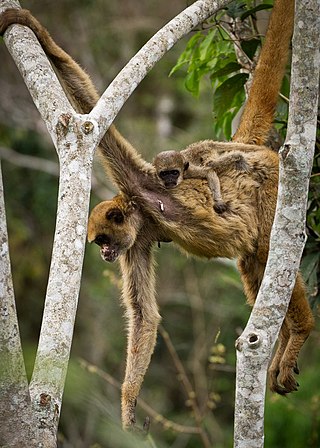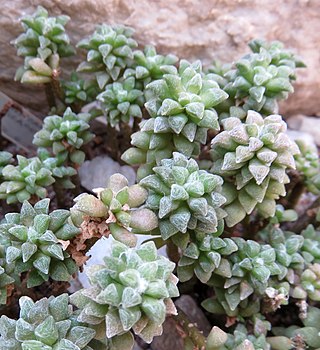
The Portulacaceae are a family of flowering plants, comprising 115 species in a single genus Portulaca. Formerly some 20 genera with about 500 species, were placed there, but it is now restricted to encompass only one genus, the other genera being placed elsewhere. The family has been recognised by most taxonomists, and is also known as the purslane family. It has a cosmopolitan distribution, with the highest diversity in semiarid regions of the Southern Hemisphere in Africa, Australia, and South America, but with a few species also extending north into Arctic regions. The family is very similar to the Caryophyllaceae, differing in the calyx, which has only two sepals.

Heikegani is a species of crab native to Japan, with a shell that bears a pattern resembling a human face – an example of the phenomenon of pareidolia – which is interpreted to be the face of an angry samurai, hence the nickname samurai crab. The crabs are named after the once powerful Taira clan which dominated medieval Japan, commonly known as the Heike. It is believed that these crabs are reincarnations of the Heike warriors defeated at the naval Battle of Dan-no-ura as told in The Tale of the Heike. While the crabs are edible, they are not eaten by most Japanese.

The northern muriqui is one of two species of muriqui. They are also known as woolly spider monkey because they exhibit the woollen pelt of woolly monkeys and the long prehensile tail of spider monkeys. Muriquis are the largest extant New World monkeys. They can reach 4.3 feet or 1.3 metres long and weight up to 7 to 10 kilograms. The northern muriqui is a critically endangered species, it is estimated that there are less than 1000 mature individuals in the wild. The species is unusual among primates in that they display egalitarian tendencies in their social relationships. This species is endemic to the Atlantic Forest region of Brazilian states of Rio de Janeiro, Espírito Santo, Minas Gerais and Bahia. Their diets, travel patterns and reproductive cycles are seasonally determined. The size of each group can fluctuate as females will move between groups of monkeys.

The southern muriqui is a muriqui species endemic to Brazil.

Calymene Brongniart, 1822, is a genus of trilobites in the order Phacopida, suborder Calymenina, that are found throughout North America, North Africa, and Europe in primarily Silurian outcrops. Calymene is closely related to Flexicalymene, and both genera are frequently found enrolled. Calymene trilobites are small, typically 2 cm in length. The cephalon is the widest part of the animal and the thorax usually has 13 segments.

Arachnoides is a genus of sea urchin within the family Clypeasteridae, found in the Indo-Pacific oceans. The base is flat and the upper surface is convex.
Libinhania arachnoides, synonym Helichrysum arachnoides, is a species of flowering plant in the family Asteraceae. It is endemic to the islands of Socotra and Samhah in Yemen. Its natural habitat is subtropical or tropical dry forests.

The spider tortoise is a species of tortoise in the family Testudinidae that is endemic to Madagascar and is one of only two species in the genus Pyxis.

Pyxis is a genus of tortoise in the family Testudinidae. It contains the following species:
Macfarlandia is a genus of tiger beetles with a single species, Macfarlandia arachnoides. Tiger beetles are placed either in the family Carabidae or in their own family, Cicindelidae, depending on the author.

Ammotrophus arachnoides is a species of sand dollar of the family Arachnoididea. Their external skeleton, known as a test, is covered with spines. It belongs to the genus Ammotrophus and lives in the sea off southern Australia. Ammotrophus arachnoides was first scientifically described in 1938 by Hubert Clark.

Heikeopsis is a genus of crabs containing two species, Heikeopsis japonica and Heikeopsis arachnoides. The genus was originally described under the name "Heikea" by Lipke Holthuis and Raymond B. Manning in 1990, but was later determined to be a junior homonym of the gastropod genus Heikea, erected by Orvar Isberg in 1934.

Anisopodus arachnoides is a species of beetle in the family Cerambycidae that was described by Audinet-Serville in 1835.

Arachnoides placenta is a species of sea urchin of the family Clypeasteridae. Their armour is covered with spines. It is placed in the genus Arachnoides and lives in the sea. Arachnoides placenta was first scientifically described in 1758 by Carl Linnaeus.

Arachnoides tenuis is a species of sea urchin of the family Clypeasteridae. Their armour is covered with spines. It is placed in the genus Arachnoides and lives in the sea. Arachnoides tenuis was first scientifically described in 1938 by Hubert Lyman Clark.
Eremophila arachnoides is a plant in the figwort family, Scrophulariaceae and is endemic to a few arid areas of Western Australia and South Australia. It is a little-known, broom-shaped shrub with white to mauve, trumpet-shaped flowers which are densely hairy on the inside.

Clypeasteridae is a family of sea urchins in the order Clypeasteroida. This family was first scientifically described in 1835 by the Swiss-American biologist Louis Agassiz.

Anacampseros arachnoides is a species of succulent plant native to the Little Karoo region of South Africa.

Leptospermum arachnoides, commonly known as the spidery tea-tree, is a species of shrub that is endemic to eastern Australia. It has rough bark, crowded linear to lance-shaped leaves with a sharp point on the end, white flowers and hairy fruit.
Paroster arachnoides is water beetle in the Hydroporini tribe of the subfamily Hydroporinae in the Dytiscidae family. It was first described by Chris Watts and William Humphreys in 2004 as Nirripirti arachnoides. It was transferred to the genus, Paroster, in 2008 by Remko Leijs and Chris Watts.













